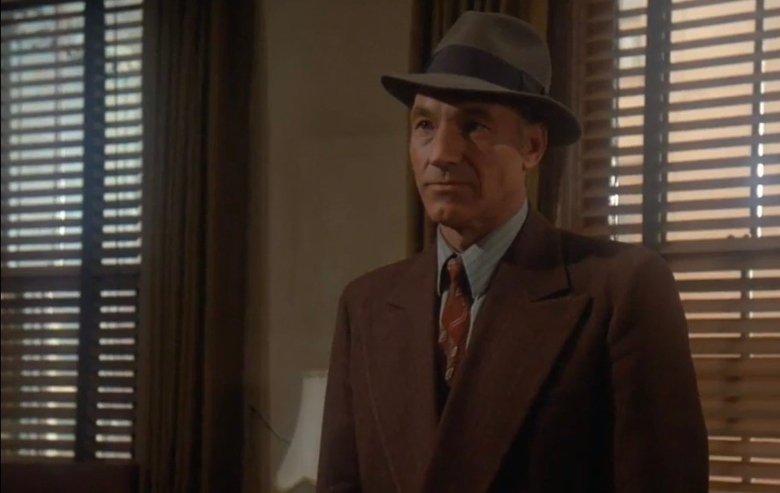
YouTube Patrick Stewart as Captain Jean-Luc Picard in the holodeck program "Dixon Hill"
One of Captain Jean-Luc Picard’s favorite holodeck programs was the Dixon Hill series. The program centered around a 1940s private detective named Dixon Hill and the mysteries he was hired to solve. Of course, Picard played the Hill character each time he entered the program.
Throughout Star Trek: The Next Generation (TNG), Picard often discussed his love of history, especially 20th-22nd century American and European history. On a few occasions, he told his crewmates that he loved mysteries as well. This tracks with his love of archaeology, which is also about solving mysteries. So, it makes sense that becoming a 1940s gumshoe would appeal to him.
In the Star Trek lore, the program was based on a series of books from the 1940s. This begs the question: are the Dixon Hill novels real or a creation of the TNG writer’s room?
The Series is Based in Reality
Though the Dixon HillI novels referenced in TNG aren’t actually real books, they were inspired by real detective novels and films.
The first episode in which fans see Picard in the Dixon Hill program is “The Big Goodbye,” which was written by Tracy Torme. According to The Star Trek: The Next Generation Companion, the idea to do a detective story in a holodeck program came from Star Trek’s creator, Gene Roddenberry. Once the idea was formed, it got passed off to Torme and the rest of the writing team.
Torme was a huge fan of the film noir genre. So when he got the opportunity to do a storyline about a detective, he decided to give the story a film noir feel. He drew inspiration from his favorite film in the genre, The Maltese Falcon. The classic movie centers on a hardboiled detective, played by Humphrey Bogart, and his quest to prevent the heist of a priceless statuette. Two of the characters in Picard’s holodeck program, Cyrus Reblock and Felix Leech, were based on characters from the movie.
Hill’s name was an homage to another film noir starring Bogart, In a Lonely Place. In that film, Bogart played Detective Dixon Steele. Initially, Torme wanted Hill to be named Dixon Steele. However, the producers were concerned that the character would be confused with Remington Steele from the wildly popular show of the same name. So, Torme decided on Dixon Hill.
The fictional Dixon Hill novels also drew their inspiration from the novels about Detective Phillip Marlowe, which many fans noticed. The Hill character has many traits similar to Marlowe, and many of the characters Hill encounters are familiar to readers of the Marlowe novels.
In Star Trek canon, the writer of the fictional Dixon Hill novel series the holoprogram is based on is Tracy Torme, a nod to the program’s real-life creator.
The Adventures of Dixon Hill Continued
The Dixon Hill holodeck program appeared in two more episodes of TNG, “Manhunt” and “Clues.”
Torme penned the script for “Manhunt,” which included the second time fans saw Picard become Hill. However, according to The Star Trek: The Next Generation Companion, he was so unhappy with the revisions to the script he asked that for his name to be removed. He used a pseudonym for his writer’s credit. In the original script Torme wrote, the Dixon Hill scenes were loosely based on the 1975 movie Farewell, My Lovely. That movie followed the adventures of none other than Detective Marlowe, confirming the connection between Hill and the famous fictional detective.
“Manhunt” was one of the last TNG episodes Torme worked on, so he didn’t have a hand in the program’s next appearance on the show. “Clues” was written by longtime Trek writer Joe Menosky and a Trek newbie, Bruce D. Arthurs. Arthurs submitted the spec script to the open submission program and it got accepted. He worked with Menosky on the rewrites and saw his idea come to life, a Trek fan’s ultimate dream. Arthurs and Menosky maintained the feel of Torme’s Dixon Hill, keeping the film noir vibe.
The Dixon Hill program also made an appearance in the TNG movie Star Trek: First Contact.
Though the Dixon Hill novel series isn’t a real thing, it was inspired by some of the best detective stories out there, and it shows.
READ NEXT: Denise Crosby Pitched the Storyline for This Classic TNG Episode
Comments
The Inspiration for Captain Picard’s ‘Dixon Hill’ Holodeck Program